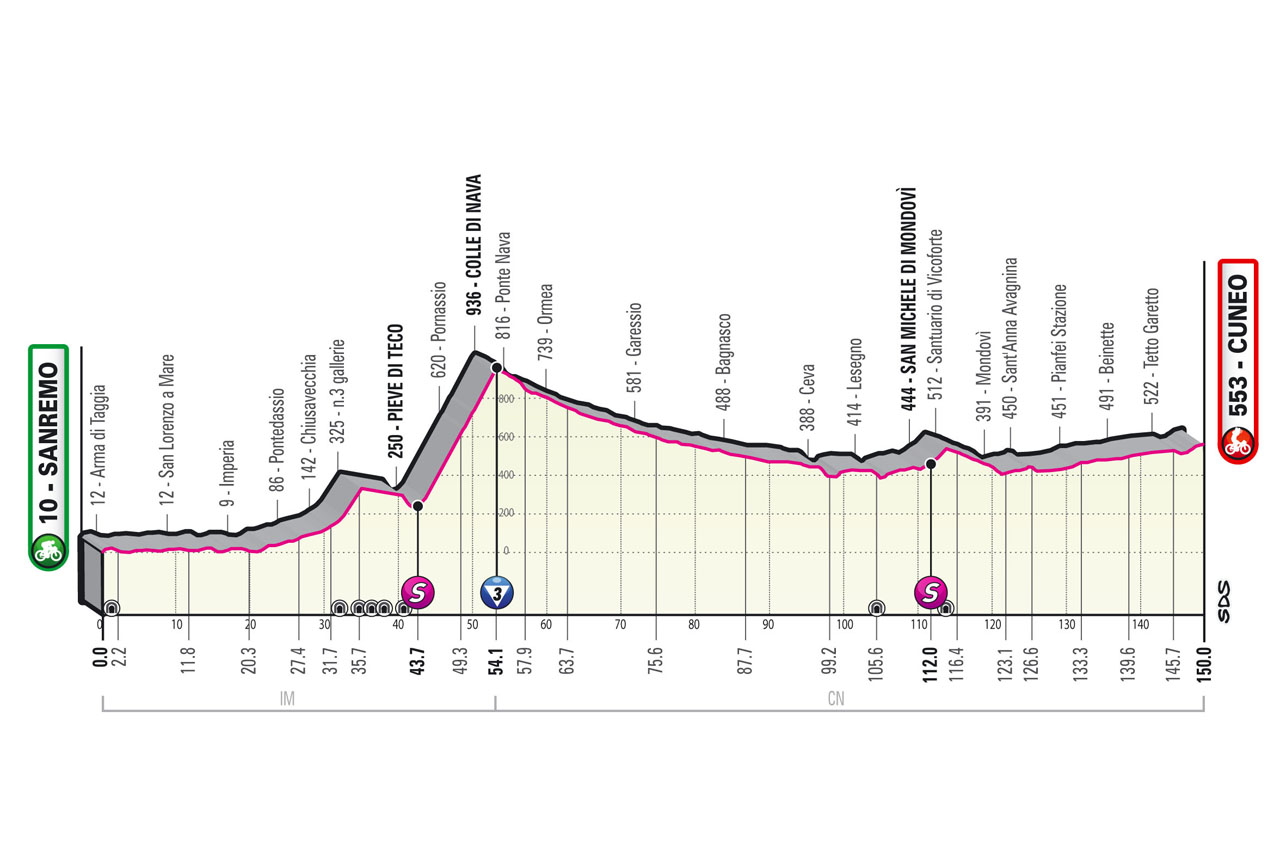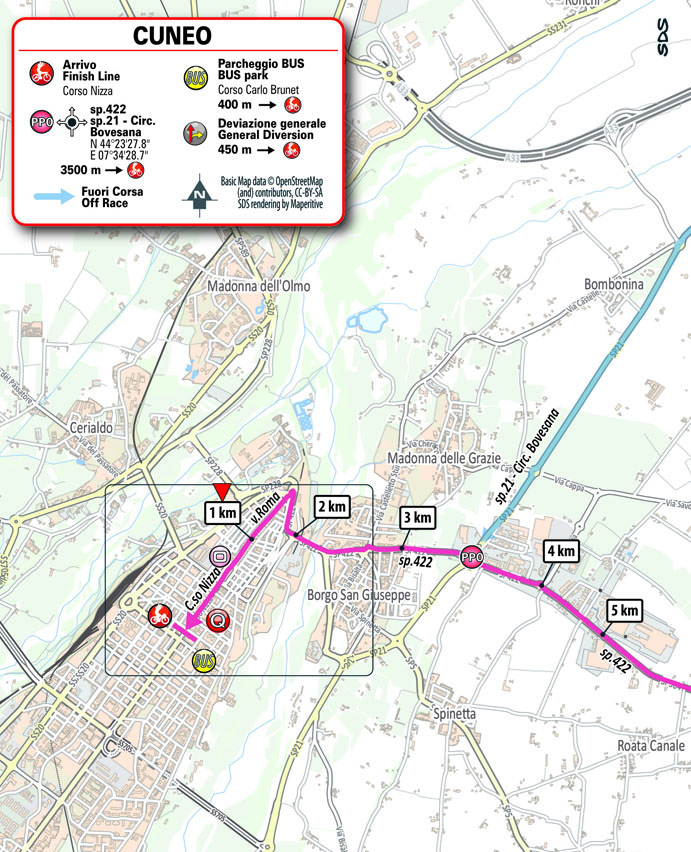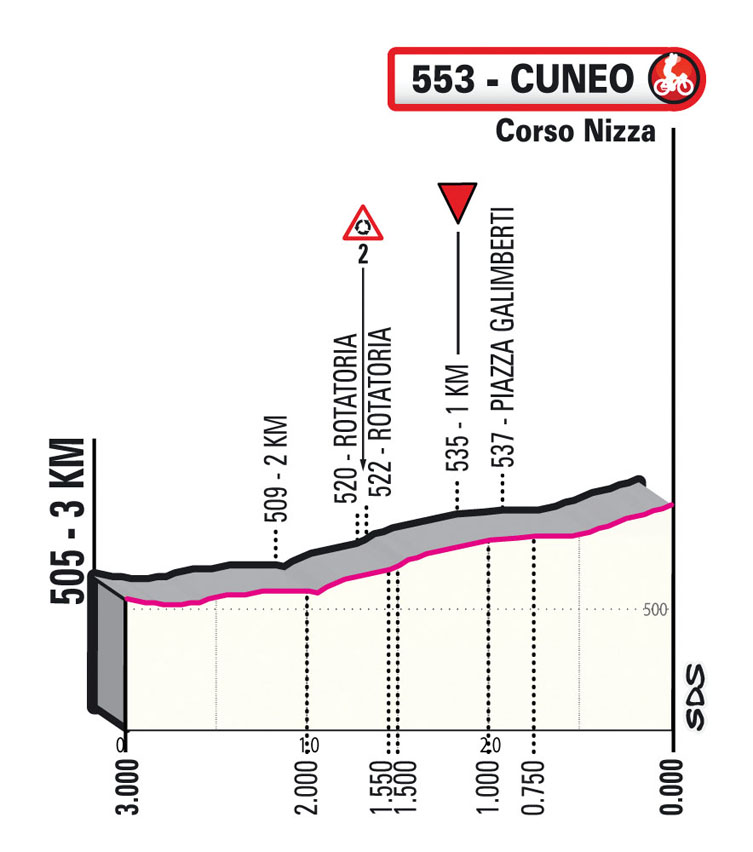profile
map
technical info
The route
After tackling one single climb, the Colle di Nava, in the first part of the route, the stage takes a long ride through the Cuneo plain. On the way up the Colle di Nava, the route passes through numerous well-lit tunnels. As soon as the stage hits the lowlands, the main obstacles will be the ones typically found in urban areas. The home straight is on a slight incline.
Final kilometres
The final kilometres are raced on wide, straight and well-paved urban roads, with a few roundabouts along the route. At the entrance of the old town, the riders will ride on flagstone for 800 metres, before taking in the last km. The home straight is on tarmac road, with an average 2.5% gradient.
start / finish
final kilometres
itinerary timetable
tourist info
Host city:
Sanremo
Overview
Sanremo, the city of music and flowers, is one of those magical places where everything – and more – seems possible. Nestled at the heart of the temperate Ligurian Riviera, and kissed by the sun, it is an attractive year-round destination. Sanremo is a place where the sea embraces the shores, with a long cycle path bordering the coast, as if it were watching over it. Sanremo is a place where culture and customs unveil right before your eyes. Sanremo is a place for outdoor sports, by the sea or in the mountains. Sanremo is a popular shopping destination, teeming with stores and boutiques, and a city of music and entertainment. Sanremo is a city for foodies, with its quintessentially Mediterranean cuisine offering the true and genuine hallmark flavours of nature.
Sanremo is all of this, and more: it’s the perfect holiday destination, all year long.
«As I child, I grew up in a town that was rather different from all the others in Italy. Back then, San Remo was still the home of old Englishmen, Russian archdukes, eccentric and cosmopolitan people». That is how the writer Italo Calvino described the town where he spent his childhood and teenage years – a town with different hidden souls that only come to light little by little.
Food
Local cuisine is a reflection of the territory, offering a combination of ingredients from the land and the sea. Traditional recipes often use basic but top-quality ingredients that will win you at first bite.
The highly prized local red shrimps, caught in the sea of the ‘city of flowers’, are among the world’s finest. They have a delicate, flavour-packed flesh, and they are usually eaten pan seared. They can be found in all the restaurants and fish shops of the city, along with plenty of other fine seafood.
Sardenaira, a scrumptious focaccia bread topped with tomato, olives, anchovies and garlic, truly embodies the combination of every possible local flavour. Named after an ancient recipe in which sardines were used instead of anchovies, sardenaira received “De.co” status (a quality scheme covering the specialty of a municipal territory) in 2012. Alongside sardenaira, in all the bakeries of the city you’ll always find a trayful of fügassa, which is eaten as a snack at any time of day. Many love to eat it together with a piece (“tocco”) of steaming hot farinata, a tasty pancake made from chickpea flour, extra virgin olive oil and water.
Your discovery of the taste of the city should definitely include a bite of crookneck squash pie, a seasonal specialty of the Riviera di Ponente. All traditional dishes, of course, are accompanied by our fine extra virgin olive oil, which can be considered as a symbol of the determination and strong will of our ancestors, who struggled against a small and sometimes unfavourable territory and succeeded in creating what now is a world-renowned sector. The olives used are exclusively of the taggiasca varietal. They are picked by hand and cold-pressed within 24 hours to ensure a top-quality genuine product.
Beverage
“Life is too short to drink bad wine”
Johann Wolfgang von Goethe
Local wine producers, who are well aware of this, have always focused on the excellence of the product, winning national and international acclaim. Even if the small size and the harsh features of our territory do not allow for a large production, the local labels are renowned for prestige and quality.
Highly regarded by wine experts and connoisseurs, Rossese di Dolceacqua was the first Ligurian wine to obtain DOC status (designation of controlled origin). It was said to be a favourite with Napoleon Bonaparte, who always wanted to have a few barrels available during his military campaigns. Ruby red in colour, with a delicate but intense aroma, it pairs well with meat dishes such as coniglio alla ligure (rabbit stew with olives and pine nuts), one of the most popular local recipes. Characterful reds also include Ormeasco, a symbol of the flavours and customs of our mountains, which is made in a valley near Imperia.
Pigato and Vermentino are favourites with white wine lovers. The former, which dated as far back as ancient Greece, is named after the word ‘Pigau’, meaning ‘speckled’ in the local vernacular, with reference to the brown dots that appear on ripe grapes. Delicate and elegant, Vermentino pairs best with the many fish dishes of the local culinary tradition.
Points of Interest
«As I child, I grew up in a town that was rather different from all the others in Italy. Back then, San Remo was still the home of old Englishmen, Russian archdukes, eccentric and cosmopolitan people». That is how the writer Italo Calvino described the town where he spent his childhood and teenage years – a town with different hidden souls that only come to light little by little.
Let’s explore it together.
- The ‘Pigna’: the old town is a maze of narrow alleys (“caruggi”), crowded with buildings, which reflects the glorious past and the customs of Sanremo. Its name describes the way the town is wrapped around itself, like scales on a pine cone. First settled around 1000 AD, Sanremo was expanded in the following centuries, and fortified for protection against foreign invasions. The highest rising buildings were a great vantage point to watch the sea and promptly sound the alarm in case of danger. To this very day, the Pigna dominates the town, below, and its unique charm remains unchanged.
- The Casino: designed by the French architect Eugène Ferret, it was first named ‘Kursal’, and inaugurated on 12 January 1905. For the first two years, it was used as a venue for parties and performances, as well as for gambling, which was not licensed, though. The Casino was officially established on 22 December 1927, by decree of Benito Mussolini. Over the years, it has hosted countless national and international personalities such as King Farouk of Egypt, the award-winning actor Vittorio De Sica, King Gustaf of Sweden, King Leopold of Belgium, Prince Rainier of Monaco, and Grace Kelly. The Casino of Sanremo was also the first “home” of the Festival of Sanremo, from 1951 to 1976.
- Teatro Ariston: located at the heart of the central Via Matteotti, the Ariston is unquestionably regarded as one of the most iconic places in Sanremo. The theatre has been the venue of the Italian song festival since 1977. Every year, it hosts some of the greatest national and international artists.
- Villa Nobel: did you know that the Nobel Prize was established in Sanremo? On November 27, 1895, from his home in Corso Cavallotti, Alfred Nobel signed his will, and established the esteemed prize for scientific and literary research. Nobel had fallen in love with Sanremo and its mild climate, and he lived here from 1891 until his death in 1896. A copy of the document, which is part of the museum’s collection dedicated to Nobel’s life and breakthroughs, is on display inside the villa.
- The bike path: the bike path is the gem and pride of the town: a wonderland by the sea, spanning 24 km from Ospedaletti to San Lorenzo al Mare, built over the former train tracks. It is the perfect destination for outdoor sports, or even just for a walk, all year round, in the mild weather. There are several kiosks, as well as bike and rickshaw rental points along the route.
- Santa Tecla: built in the mid-1700s by Genoa against the “riotous inhabitants of Sanremo”, the fort of Santa Tecla served as barracks under Napoleon’s rule, and as city prison from 1864 to 1997. The fort, built adjacent to the old port, is one of the rare surviving examples of 18-century military architecture in the region.
Cuneo
Touristic Information
Cuneo, capital of the Granda province, is located on a plateau that widens and opens into the majestic fun of the south-western Alps. Completely immersed in nature, surrounded by the Gesso and Stura River Park, it has earned the nickname of Green Capital of Piedmont.
Founded in the Middle Ages (1198), it is a welcoming and hospitable city, which winds over more than 8 km of porticoes, a long open-air shopping centre divided between the historic centre and the new city. The two souls are held together by the elegant Piazza Galimberti, surrounded by neoclassical buildings, which keeps alive the memory of the Resistance that allowed Cuneo to be awarded with the Gold Medal for Military Value.
Typical mountain resort, Cuneo is the ideal starting point for a journey to discover the Maritime Alps, by hiking, climbing, mountaineering, mountain biking and skiing.
Gastronomy
Cuneo’s gastronomic personality is expressed in dishes that combine ancient habits and an austere but, at the same time, joyful collection of recipes: appetizers, especially based on vegetables, led by Cervere leek, some first courses closely linked to local products (potatoes and wheat flour), game (from wild boar to chamois and so on), the amazing porcini mushrooms, cheeses and chestnuts and the queen of meat, the Piemontese beef.
Stuffed vegetables, omelettes and savoury pies are the traditional first courses of this region. To name a few: caponèt (the o is read u), siole piene , friceuj ‘d ris, subric (mashed potatos, egg, cheese and salt cooked and mixed), aromatic herb omelette, green pie and potato pie.
Game, noble mushrooms and large boiled meats, but also rare delicacies such as snails (like the Helix Pomatia Alpina of Borgo San Dalmazzo, protagonist of the ancient Cold Fair) or eels, are included in the offer for the main course.
A taste of local cheeses is not to be missed. Toma, popularly defined as “Piemontese”, Tomini di Melle (Varaita Valley), Raschera and Castelmagno are the “fabulous four” worthy of mention.
The selection of desserts is small but special: few traditional sweets like bonét and fruit cakes are the perfect conclusion of the meal.
Finally, it is worthy of note the “queen” of the Cuneo culinary tradition: the chestnut. It is not a surprise that the tree that produces the fruit is also called the bread tree because the man draws gastronomic and commercial benefits from it, selling fruits, leaves and timber. The hilly and foothill landscape of Cuneo has been characterized by this friendly tree for centuries. At the table, it can be enjoyed in the fabulous Castagnaccio cake o in the refined Montebianco cake.
A visit to Cuneo wouldn’t be concluded without a taste of the famous Cuneese al Rhum (rum truffles) that Hemingway enjoyed when he stayed in the city in 1954.
Beverages
Cuneo and wine are an inseparable combination. The wines are the highest and most universally known expression of the Cuneo region. Cuneo is recognized as a land of great wines for its number of DOC and DOCG wines and for the vineyards with designation of origin and produces the most famous Italian wine in the world, Barolo. The Cuneo viticulture, exclusively hilly, dominates the land of the Langhe and the Roero, extends up to Dogliani and Monregale and occupies some hills of Saluzzo.
The quality of the wines comes directly from the grapes and from the experience of winemakers who continue to produce wines in respect of tradition, while keeping an eye to new trends. Tradition that is maintained in the viticultural heritage based on native vines, the result of a vine-territory evolution matured over time.
The rows of vines draw an extraordinary and evocative landscape, marked by ancient castles and small villages perched on top of the hills. The rediscovery of the values of quality and tradition started from the wine, extended to other gastronomic products and became a cultural movement.
Instead, craft beer, which has recently become another flagship product of Cuneo’s enogastronomy, has a more recent but equally prolific history. The many artisan companies are able to keep together the traditional values with a careful production of local blends and herbs, producing beers different in colour, roundness and sweetness, but able to offer new and exciting sensory experiences and a clean and balanced taste. The best to combine unique and personalized fragrances with local cuisine.
Finally, the Alps that embrace the plain offer a variety of quality mineral waters, thanks to springs that flow in high mountains and that give light, uncontaminated and low sodium waters.
Main sights
Piazza Galimberti is the core of Cuneo and unites the two souls of the city, the ancient Contrada Maestra (today Via Roma) and the nineteenth-century Corso Nizza, which cross the whole city cutting it into two similar parts. Both arteries, flanked by eight kilometres of porticoes, offer various shopping opportunities and are the mirror of the centuries of the city’s history imprinted in its stones.
In Via Roma, recently affected by a series of redevelopment works that have brought the beautiful medieval buildings back to their original splendour, with the portals of the oldest churches (including Baroque jewels such as the Church of Sant’Ambrogio) that overlook the street, there are the Town Hall, the ancient Civic Tower and the houses of the old nobility. The narrow streets hide treasures such as the churches of Santa Chiara and Santa Croce, Contrada Mondovì with the synagogue of the former Jewish ghetto, the Toselli Theatre and the medieval palaces of Piazza Virginio dominated by the former church of San Francesco, recently renovated and part of the most important monumental complex in the city.
The entire city of Cuneo is completely surrounded by the Gesso and Stura River Park, a protected area of over 5,500 hectares that embraces the entire plateau and extends to 14 other municipalities towards the mountains, until the Natural Park of the Maritime Alps. To fully enjoy the nature and landscape of the park, over 100 km of paths have been identified suitable for hiking or cycling with poles, bulletin boards and lecterns able to guide visitors to discover the territory and its naturalistic and historical-cultural traits.
In addition to the River Park, in Cuneo there are numerous avenues and gardens, the most famous of which are Viale degli Angeli, created in 1720 to connect the city with the Sanctuary of the Madonna degli Angeli, the Park of the Resistance, where Monument to the Italian Resistance is located, and the new Parri Park, a small Central Park nestled in the south of the city with over 8 hectares of park area, a naturalistic lake, orchards, gardens, urban forest, play areas, sports training stations and over 3 km of cycle and pedestrian paths.

















































































































